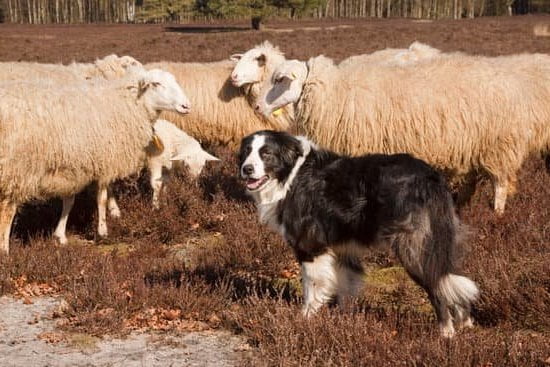Are you struggling with the challenge of how to train an older dog to stay off furniture? Many pet owners find themselves facing this dilemma as their beloved furry companions age. In this article, we will explore the difficulties of training an older dog and the benefits of keeping them off furniture. We will delve into the reasons why older dogs may be drawn to lying on furniture and provide effective strategies for setting boundaries and redirecting their behavior.
As our canine companions age, they may experience physical discomfort or mobility issues that make it tempting for them to seek out the comfort of furniture. However, allowing them to do so can lead to a variety of complications such as shedding, odors, and potential damage. By understanding these challenges, pet owners can take proactive steps to keep their older dogs off furniture while still providing them with a comfortable and inviting environment.
It’s important for pet owners to recognize the benefits of training an older dog to stay off furniture. Not only does it help maintain cleanliness and upkeep in the home, but it also promotes positive behaviors and respect for boundaries. In addition, it can contribute to the overall well-being of the dog by encouraging them to engage in appropriate activities instead of lounging on furniture all day.
Understanding the Behavior
As dogs age, they may experience physical discomfort or joint pain, which can lead them to seek out soft and comfortable places to rest, such as the furniture. It’s essential to understand that older dogs may be drawn to the furniture because it provides them with a sense of security and comfort. Additionally, being on the furniture allows them to be close to their owners, which can be particularly comforting for an aging dog.
To address their desires to be on the furniture, it’s crucial to first ensure that your older dog has a comfortable and supportive bed of their own. This bed should be placed in a warm and quiet area of the house, away from any drafty areas or high-traffic areas. Providing this designated space for rest can help discourage your older dog from seeking out the furniture for comfort.
Additionally, consider the use of pet stairs or ramps to make it easier for your older dog to access their designated resting area. These simple accommodations can make a significant difference in your older dog’s preference for staying off the furniture. Furthermore, praise and reward your older dog when they choose to use their designated bed instead of the furniture, reinforcing positive behavior with treats or words of encouragement.
- Understand that physical discomfort may drive older dogs to seek out comfortable places like furniture
- Provide a designated comfortable bed away from drafty or high-traffic areas
- Consider using pet stairs or ramps for easier access to their resting area
- Praise and reward your older dog when they choose their designated bed over the furniture
By addressing your older dog’s desires for comfort and security in a thoughtful manner, you can effectively train them to stay off the furniture while still ensuring they have a cozy place of their own within your home. Understanding and addressing their behavior with patience and compassion is key in successfully training an older dog in this aspect.
Setting Boundaries
Training an older dog to stay off furniture can pose some unique challenges, but with patience and consistency, it is possible to establish clear boundaries for your furry companion. Here are some effective ways to set rules and boundaries when it comes to furniture access:
- Use verbal commands: Teach your older dog a specific command, such as “off” or “down,” to communicate that they are not allowed on the furniture.
- Designate specific areas: Create designated resting spots for your older dog, such as a cozy bed or cushion, and gently guide them to these areas when they attempt to climb onto the furniture.
- Utilize physical barriers: Use pet gates or baby gates to block off access to certain rooms or pieces of furniture where you do not want your older dog to go.
Consistency in enforcing these rules is crucial for your older dog to understand and follow them. Additionally, providing positive reinforcement and rewards when your dog complies with the established boundaries can help encourage good behavior.
It’s important to be patient and understanding throughout this training process. It may take time for your older dog to adjust to the new rules, so approach the training with empathy and consistency. By setting clear boundaries and being consistent in their enforcement, you can effectively train your older dog to stay off the furniture while ensuring their comfort and well-being.
Providing Alternatives
As older dogs age, they may struggle with staying off furniture due to arthritis, joint pain, or simply because they have become accustomed to the comfort of being on it. Providing comfortable and inviting alternatives for them to relax on is crucial in training an older dog to stay off furniture. This not only helps in keeping the furniture clean and free from pet hair but also ensures the dog’s comfort and well-being.
One effective alternative to furniture for older dogs is providing them with orthopedic dog beds. These beds are specifically designed for older dogs’ comfort, offering extra support for their achy joints and muscles. Placing these special beds in areas where your older dog likes to relax can help encourage them to choose these comfortable alternatives over the furniture.
Another alternative that can help keep an older dog off furniture is providing cozy blankets or mats placed in their favorite spots. Look for soft materials that offer warmth and cushioning, making these spots equally inviting as the furniture they are used to lounging on. Additionally, consider placing these blankets or mats near you so your dog doesn’t feel isolated when adhering to the no-furniture rule.
Additionally, creating a designated “dog zone” in your home with appropriate bedding and toys can redirect your dog’s attention away from the furniture. This area should be inviting and comfortable enough for your older dog to enjoy spending time in. By providing appealing alternatives like orthopedic beds, cozy blankets, and a designated space of their own, you can successfully train your older dog to stay off furniture without compromising their comfort and well-being.
| Alternatives | Details |
|---|---|
| Orthopedic Dog Beds | Designed for older dogs’ comfort and support |
| Cozy Blankets or Mats | Offer warmth and cushioning as an inviting alternative |
| Designated “Dog Zone” | An area with appropriate bedding and toys for redirection |
Consistency Is Key
Training an older dog to stay off furniture can be a challenging task, but consistency is key when it comes to reinforcing the no-furniture rule. Older dogs may have established habits and behaviors, so it’s essential to consistently enforce the rules and provide clear boundaries for them. By emphasizing the importance of consistent training and reinforcement, you can effectively teach your older dog to stay off the furniture.
Establishing Clear Rules and Boundaries
Set clear rules and boundaries for your older dog when it comes to furniture access. Be firm and consistent in enforcing these rules, ensuring that everyone in the household follows the same guidelines. Consistency is crucial in sending a clear message to your older dog about what behavior is acceptable regarding furniture.
Regular Training Sessions
Consistent training sessions are essential for reinforcing the no-furniture rule with an older dog. Take time each day to work on commands such as “off” or “down”, using positive reinforcement techniques. It’s important to remain patient and persistent during these training sessions, as it may take time for your older dog to understand and comply with the new rules.
By consistently providing clear rules, boundaries, and regular training sessions, you can effectively reinforce the no-furniture rule with your older dog. Remember that patience and understanding are key when working with an older dog, as it may take some time for them to adjust to new behaviors and habits.
Positive Reinforcement
As older dogs can be set in their ways, positive reinforcement is an effective technique to encourage them to stay off the furniture. Positive reinforcement involves rewarding your dog for exhibiting the desired behavior, in this case, staying off the furniture. This can be achieved through the use of treats, praise, and even toys to motivate and reinforce the behavior you want.
One method of positive reinforcement is using treats to reward your older dog when they choose to stay off the furniture. Whenever your dog voluntarily stays on their designated spot instead of hopping onto the couch or bed, immediately provide them with a treat and verbal praise. Over time, your dog will associate staying off furniture with receiving a reward, making it more likely for them to continue this behavior.
In addition to treats, verbal cues such as “good boy” or “good girl” followed by petting and affection are forms of positive reinforcement that can help encourage your older dog to stay off the furniture. Dogs respond well to affection from their owners and will often seek approval from them. By providing verbal praise and physical affection when they obey the no-furniture rule, you are reinforcing the behavior and strengthening their desire to comply with your wishes.
| Positive Reinforcement Techniques | Benefits |
|---|---|
| Use of treats | Motivates and reinforces desired behavior |
| Verbal cues and affection | Strengthens desire to comply with rules |
Redirecting Behavior
When training an older dog to stay off furniture, it is essential to understand that simply telling them “no” may not be enough to change their behavior. Older dogs, especially those who have been allowed on furniture for many years, may be resistant to this new rule.
Therefore, it is important to focus on redirecting their attention and energy towards more appropriate activities. By doing so, you can help the older dog find alternative ways to relax and enjoy their space without relying on the furniture.
Interactive Toys and Games
One effective way to redirect an older dog’s attention away from the furniture is by providing them with interactive toys and games. Interactive toys such as puzzle feeders or treat-dispensing toys can keep their minds engaged and provide mental stimulation. Playing games like hide and seek or practicing obedience commands can also redirect their energy in a positive way. By engaging in these activities, the older dog will be less likely to seek out the furniture for entertainment.
Designated Resting Area
Creating a designated resting area for the older dog can help redirect their attention away from the furniture. This area should be comfortable and inviting, with a cozy bed or blanket where they can relax.
Placing this designated resting area in a spot where the dog enjoys spending time can help make the transition easier. Using positive reinforcement techniques when the dog chooses to rest in this area will also encourage them to continue using it instead of seeking out the furniture.
Regular Exercise
Ensuring that an older dog receives regular exercise is crucial for redirecting their energy away from the furniture. Daily walks, playtime, or other forms of physical activity can help tire them out and reduce any pent-up energy that may drive them towards seeking out elevated surfaces like couches or beds. By keeping them physically active, you can help prevent boredom and restlessness that may lead to unwanted behavior around furniture.
By implementing these redirection techniques, pet owners can effectively train an older dog to stay off furniture while keeping them engaged in more appropriate activities. It is important to remember that consistency and patience are key components of this process as it may take time for an older dog to adjust to new rules and behaviors.
Patience and Understanding
In conclusion, training an older dog to stay off furniture can be a challenging but ultimately rewarding process. By understanding the behavior of older dogs and setting clear boundaries, pet owners can help their furry companions adjust to new rules and behaviors. It’s important to offer comfortable alternatives for the dog to relax on and to consistently reinforce the no-furniture rule with positive reinforcement techniques.
Additionally, patience and understanding are key when training an older dog. It may take time for them to fully adjust to the new rules, so pet owners should be prepared for a period of transition. It’s crucial to redirect their attention away from the furniture and onto more appropriate activities, while also providing love and support during this adjustment period.
Ultimately, by approaching the training process with empathy and consistency, pet owners can successfully train an older dog to stay off furniture. With patience and understanding, both the dog and its owner can enjoy a harmonious living space that respects everyone’s boundaries and needs.
Frequently Asked Questions
Can You Teach an Older Dog to Stay Off Furniture?
Yes, it is possible to teach an older dog to stay off furniture. This can be accomplished through consistent training and positive reinforcement. Using commands such as “off” and providing alternative comfortable spots for the dog to rest can help in breaking the habit of jumping on furniture.
How Do You Keep Your Dog Off Furniture?
One way to keep your dog off furniture is by using physical barriers such as baby gates or pet gates to restrict access to certain areas of the house. Additionally, providing a comfortable bed or mat for your dog to lie on can encourage them to stay off the furniture.
Consistency in enforcing rules and positively reinforcing good behavior is key.
How Do You Train an Old Dog to Stay Off the Bed?
Training an old dog to stay off the bed involves setting clear boundaries and consistently reinforcing them. Providing a comfortable alternative sleeping area, such as a cozy dog bed, can help in redirecting their behavior. Using positive reinforcement techniques, such as treats and praise, can also be effective in teaching an old dog to stay off the bed.

Welcome to the blog! I am a professional dog trainer and have been working with dogs for many years. In this blog, I will be discussing various topics related to dog training, including tips, tricks, and advice. I hope you find this information helpful and informative. Thanks for reading!





